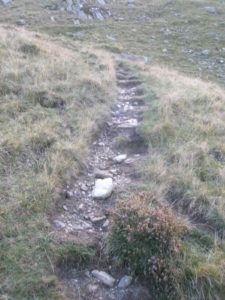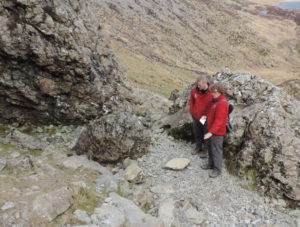Path erosion is a combination of the effects of the elements and the effects that people have on the ground.
 Once the vegetation and soil structure has been weakened by people’s feet, water and wind carry the soil away until the bedrock or a layer of stones and rocks in the soil is reached. Areas that have been eroded like this appear like scars in the landscape, which can mar an areas beauty or threaten habitats as the erosion areas expand.
Once the vegetation and soil structure has been weakened by people’s feet, water and wind carry the soil away until the bedrock or a layer of stones and rocks in the soil is reached. Areas that have been eroded like this appear like scars in the landscape, which can mar an areas beauty or threaten habitats as the erosion areas expand.
Snowdonia and Cwm Idwal have a high annual rainfall, and the comparatively low temperature in this mountainous area means that plant growth is comparatively slow. This can create very difficult conditions for plants to re-colonise areas of erosion. The rate of erosion in an area depends of the angle of the slope, the climate, and the type of vegetation covering the soil. Heavy showers can release and move soil on their own, and if the soil is saturated the water will move more quickly down the mountain. This can be seen happening in areas where soil that has been compacted by foot, because these soils hold less water than soils that have not been compacted. When the soil is saturated on a level part of a path, it forms a pool. More often than not, walkers try to avoid such pools and walk around them, increasing the area that is being eroded.

Different types of soil also contain varied levels of carbon, with peat containing the highest concentration. Erosion on peat results in the release of carbon dioxide, which is one of the gases that contributes to global warming.
In Cwm Idwal, tackling erosion is a challenge to the partnership, as the three organisations want to provide opportunities for the public to enjoy the National Nature Reserve, but attacting more people to the area leads to an increase in foot fall, and erosion as a result.